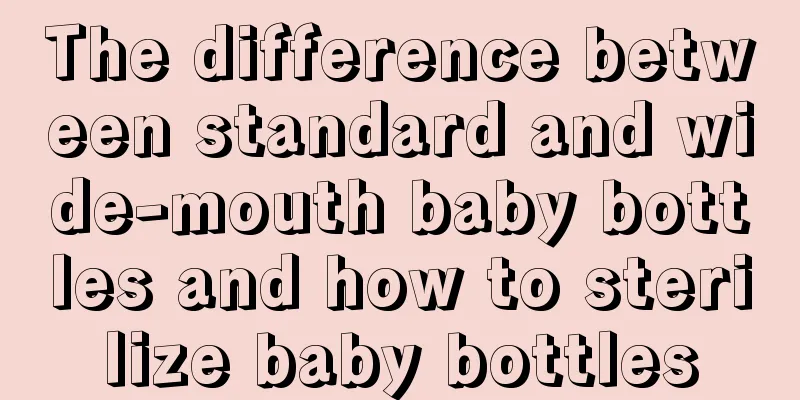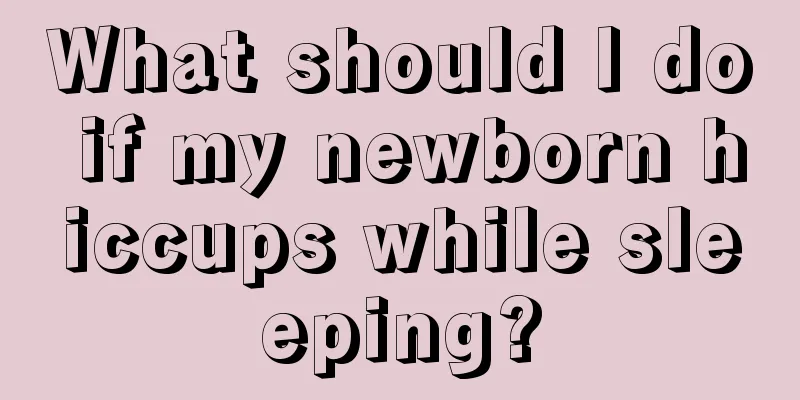The difference between standard and wide-mouth baby bottles and how to sterilize baby bottles

|
Baby bottles are a very common baby product in our daily lives. We often see many babies using baby bottles. Baby bottles come in many different materials, brands, and sizes. Many new mothers don’t know how to choose. The difference between standard and wide-mouth baby bottlesBaby bottles are classified according to the size of the caliber, generally divided into standard caliber and wide caliber baby bottles. The differences between standard caliber and wide caliber baby bottles are as follows: Standard caliber baby bottle Size: The diameter of a standard-mouth baby bottle is usually 3.5 cm. advantage: ①The biggest advantage of the standard mouth is that it is simple and easy to use with other products, such as bottle handles and nipples, which are very easy to buy. In addition, most standard mouths are of the same size, so they can often be used interchangeably. For example, Pigeon's standard mouth bottle can be conveniently used on the Medela breast pump. Even the nipples of some brands of standard mouth bottles are interchangeable, which is a good combination. ②The standard-caliber bottle has a slender body, making it easier for mothers and babies to hold. ③The diameter of the nipple that comes with a standard-caliber bottle is more suitable for babies under one year old. The diameter of a wide-caliber nipple is too wide and is not conducive to sucking for newborn babies. ④The price is cheaper than wide-mouth baby bottles. Disadvantages: The standard-caliber baby bottle has a smaller mouth, which makes it less convenient to clean and pour milk powder. Wide-mouth baby bottle Size: The diameter of a normal wide-mouth bottle is 5 cm, and the diameter of an extra-wide-mouth bottle is 6.6 cm. advantage: ① Wide-mouth bottles have larger mouths, so they are more convenient for preparing milk powder and cleaning. ②The base of a wide-mouth bottle stands more steadily and is less likely to tip over. ③The diameter of the wide-mouth pacifier is too wide and is not suitable for babies over one year old. ④Wide-mouth baby bottles are now a popular trend in choosing baby bottles. shortcoming: ① In terms of price, because the bottle body uses more materials, and the diameter of the matching nipple increases, the raw materials also increase, so the price is more expensive than the standard caliber. ② Because it is not a unified standard design, it is not easy to use with many other products. For example, some wide-mouthed bottles are not easy to put into the milk warmer, some wide-mouthed bottles are not easy to match with handles, and the selection of pacifiers that match wide-mouthed bottles may be narrower, such as some brands of wide-mouthed pacifiers do not have a cross-mouth design. Summary: In fact, the choice of standard-caliber and wide-caliber feeding bottles has little impact on the baby. If the nipples are the same, the baby will feel the same. It mainly depends on the impact on the mother when using it. It depends on which one is more convenient for the mother to use. It is recommended that the mother make a reasonable choice according to her own needs. How to sterilize baby bottles1. Boiling disinfection method ① Prepare a stainless steel cooking pot filled with cold water. The depth of the water should be able to completely cover all the cleaned feeding utensils. ② If it is a glass bottle, you can put it in the pot together with cold water. Wait 5 to 10 minutes after the water boils, then put in the pacifier, bottle cap and other plastic products. Cover the pot and cook for another 3 to 5 minutes, then turn off the heat. Wait until the water cools down a little, then use a sterilized bottle clip to take out the pacifier and bottle cap, and put them back on the bottle after they are dry for later use. ③If it is a plastic bottle, wait until the water boils, then put the bottle, nipple, and bottle cap into the pot for sterilization. Cook for about 3 to 5 minutes. Finally, use a sterilized bottle clip to pick up all the tableware, place it in a clean and ventilated place, and turn it upside down to drain. Note: Plastic utensils should not be boiled for a long time, so it is recommended to put them in after the water boils and boil for 3 to 5 minutes, otherwise they will easily go bad. You can also pay attention to the temperature resistance mark on the bottle. If it is not resistant to high temperatures, it is best to use a steam cooker to sterilize it. 2. Microwave disinfection Microwave sterilization is a simple and quick sterilization method. Put the cleaned bottle in water and put it in the microwave oven, turn on high heat for 10 minutes. Do not put the nipple and the connecting cover into the microwave oven to avoid deformation and damage. After microwave sterilization, the water left in the bottle should be completely poured out, and the bottle should be placed in a clean and ventilated place to cool after being drained upside down. 3. Steam pot sterilization method Natural steam can kill 99.9% of harmful bacteria and also avoid damage to the baby bottles. There are many functions and brands of electric steam cookers on the market. Parents can choose according to their needs. The sterilization method only needs to follow the instructions to achieve the purpose of sterilizing feeding utensils. Generally, pour 100 ml of tap water into the water tank at the base of the steam sterilizer, place the large steam basket on the base, and then place the small steam basket on the large steam basket. Put the baby bottles on and cover the top cover of the small steam basket. Then plug in the power supply and press the power start button to start sterilization. After ten minutes, the sterilization is completed and the steam sterilizer will automatically shut down. 4. Chemical disinfectant immersion method Soak the baby bottle in 0.5% peracetic acid solution for 30 minutes, or in 0.1% potassium permanganate solution for 30 minutes, or in 10g of effective chlorine disinfectant such as TD for 2-3 minutes per kg, then take it out and rinse it with water. Because chemical disinfectants are not easy to find, many mothers are afraid to use them, so this method is not suitable for ordinary families. Precautions when sterilizing baby bottles1. Pay attention to drying the bottle After the baby's bottle is sterilized, the water left in the bottle should be poured out thoroughly, then turned upside down to drain, and use a sterilized bottle clip to clip the sterilized bottle, nipple, bottle cap, etc., and place it in a ventilated, clean place to cool for later use, and cover it with gauze or a lid. 2. Disinfection in time If the bottle is still not used after 24 hours of sterilization, it needs to be sterilized again to prevent bacteria from growing. After the baby finishes drinking milk, the mother can first clean the bottle with a bottle brush, collect and place it on the bottle rack to dry, and then sterilize it together when a certain number of bottles are accumulated or the size that the sterilizer can accommodate. Therefore, the mother must prepare a lot of bottles at a time to meet the baby's daily needs. 5 common mistakes when using baby bottles1. Let your baby lie down and drink from the bottle Many parents like to let their babies lie down to drink milk. This position seems very comfortable, but it may easily cause the baby to suffer from otitis media. This is because it is easy for milk to flow into the Eustachian tube when lying down to drink milk, which can easily cause inflammation. Moreover, if the baby lies down to drink milk for a long time, it is likely to cause the baby to develop an overbite. Therefore, try to let the baby sit upright to drink milk, or drink milk in a semi-upright position. 2. Let your baby sleep with a bottle in his mouth Many babies like to sleep with a bottle in their mouths. In fact, this is very bad for the baby's teeth. This is because milk powder contains sugars, which may produce some acidic substances after fermentation. If the baby holds the bottle for a long time, the teeth will undoubtedly be immersed in these acids for a long time, which can easily cause tooth decay problems in the baby's teeth. 3. Let your baby empty the bottle Sometimes, when babies drink milk from bottles, they like to empty the bottles because they don’t drink enough. In fact, this practice can easily cause babies to swallow a lot of air. In severe cases, it may cause paroxysmal intestinal cramps and abdominal pain in babies. If this continues for a long time, babies may also suffer from aerophagia. So it’s not a big deal. Babies should not be allowed to empty the bottles. Breastfeeding babies should not be allowed to feed for too long. The maximum time is about 20 minutes. After feeding, you should also hold the baby and burp him. 4. Sterilize the bottle only after use Generally, parents will sterilize the baby's bottle after the baby finishes feeding, and then rinse it and use it to make milk directly next time. In fact, this is not right. Because the baby's body is not yet mature, his immunity may be relatively low. Therefore, before making milk powder for the baby, the bottle should be sterilized again to avoid bacteria generated in the middle, which will cause harm to the baby's body. 5. Ignore the expiration date of the bottle There is a time limit for babies to use bottles. Many parents think that as long as the bottle is not broken, it is okay to keep using it. In fact, bottles also have a shelf life, especially plastic bottles, which generally have a shelf life of about half a year. Glass bottles may have a longer shelf life, but generally need to be replaced after about a year and a half. |
<<: How about Anman pregnant women milk powder? Price of Anman pregnant women milk powder
>>: What to do if your child has poor social skills? 5 steps to become a social expert
Recommend
What should I do if my baby gets prickly heat in summer? How to prevent my baby from getting prickly heat?
Summer is here, and the baby's prickly heat p...
Will my salary be deducted if I take maternity leave? National regulations on maternity leave in 2022
Pregnant women need to go for prenatal checkups o...
Can you eat mutton in early pregnancy? Precautions for pregnant women to eat mutton
In our daily life, many people like to eat mutton...
Can children eat chocolate? At what age can they eat chocolate?
Many parents like to eat chocolate themselves and...
What to do if your baby has diarrhea 10 days after birth? 8 ways to avoid medication
Newborns are very fragile, and their gastrointest...
How to massage your baby to make him grow taller? Easy massage helps him grow taller
During the infant and toddler period, babies need...
How to reduce children's learning pressure and what are the behavioral reactions
Children may feel pressured by exams during schoo...
Is Yunnan Baiyao toothpaste authentic? How to distinguish the authenticity of Yunnan Baiyao toothpaste?
The price of a tube of Yunnan Baiyao is not cheap...
Which flavor of Baoning soap is the best? How many flavors does Baoning soap have?
Which of the Boryeong soaps smells good? When mot...
Can pregnant women eat Swiss chard?
Swiss chard, also known as thick-skinned vegetabl...
What causes children to be picky eaters? What causes children to be picky eaters?
Many babies give parents a headache when it comes ...
What are the consequences of a child's severe calcium deficiency?
Calcium deficiency in children is a relatively co...
Can newborns have their nails cut? What should I do if my newborn's nails are cut on the flesh?
Cutting nails is a very common thing. We all know...
What are the symptoms of neonatal jaundice? Treatment of neonatal pathological jaundice
If the bilirubin in the baby's body is too hi...
Pay attention to the correct steps of bathing newborns
[The baby smells so good! Pay attention to the st...









